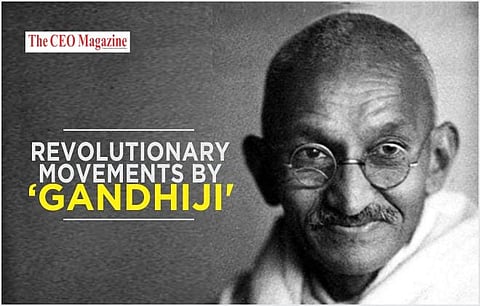
- News
- Women
- Magazine
- IndustryIndustry
- InsightsInsights
- Success Stories
- PublishPublish
- ContactContact
- Media KitMedia Kit

Revolutionary Movements led by ‘Gandhi’
Revolutionary Movements led by ‘Gandhi’
It is not obvious that if a person who is born in a royal family or has a lot of information in his mind is a great person. A great man is made by his great thoughts. A great human wants to work in favor of society and bring a positive change for a better future.
Mahatma Gandhi also knows as the father of our nation was also a simple man like us but has great thinking. He was the man who brings the whole country together to walk against British rule. Because of his great thinking, he was able to change the life of many people. He started many movements against the British rule.
On this 2nd October 2019 is Bapu's 150th birthday and we are going to learn about his efforts and how it leads to the freedom of our nation.
Champaran Movement
This was also known as Champaran Satyagraha and it started after Mahatma Gandhi returns from South Africa and began his efforts toward India's Independence. This was initiated in the Champaran district of Bihar in the year 1917. This movement was to raise the voice of farmers because their landlord was forcing them to grow only indigo and to sell at a fixed price. To get rid of this obligation they asked help from Gandhi Ji.
When he visited Champaran to help them, he was surrounded by the farmers. Due to this, British officers ordered him to leave the district immediately but he didn't. After Gandhi Ji went against their order, the British government decided to put Gandhi into jail and the next day before Gandhi would appear in the courtroom a huge crowd of farmers gathered to protest for Gandhi. Sacred of this situation, the British government clear off all the charges on Gandhi Ji.
In effect of this, the British government formed a committee and they invited Bapu as well. He fought for the farmers and in the end; Champaran Satyagraha lead by Gandhi was won.
Kheda Satyagraha
One of the most successful movements against British rule was Kheda Satyagraha in the year 1918. Crops of farmers in kheda village were destroyed due to flood and they were unable to pay taxes to the British government. Mahatma Gandhi started this satyagraha to force Britishers to declare relief for the farmers by lifting their tax rules. This movement was also successful and lead to another defeat for the British government.
Ashoyg Movement
Ashoyag satyagraha also known as the Non-cooperation movement was started by Mahatma Gandhi in the year 1920. This movement took place when British general dyer ordered to shoot at the defenseless people protesting against the Rowlatt act by the British government at Jalliawala Bagh on April 13, 1919. That was a horrific act done by the British government in which many innocent men, women, and children died.
Gandhi decided to boycott government posts, schools, goods, and even clothes. But due to the incident that took place at Chaura Chauri, Mahatma Gandhi halted this movement in the year 1922.
Dandi March
Also known as the Salt Satyagraha, Mahatma Gandhi started this movement to break the ban on making salt which was imposed by the government. Gandhi Ji alongside his 72 followers walked from Sabarmati Ashram to Dandi village on foot and covers almost 240 km in 24 days. On the coast of Dandi village, they disobey the rules of Britishers by making salt there, because of this the whole country started making salt. This was the incident that made Mahatma Gandhi popular all around the world.
Quit India Movement
This was the most effective movement started by Mahatma Gandhi; it forced the British government to go back. It started in the year 1942 and this made it clear in the heads of the government that they can't rule India for long now and then on 15 August 1947 we got our independence.
Follow us on Google News
